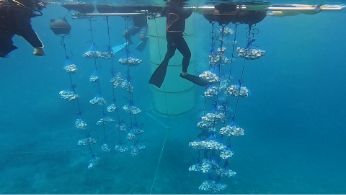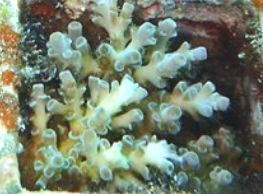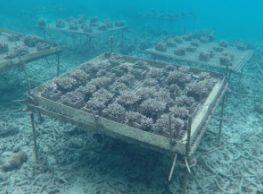Coral restoration techniques
Source: A Guide to Coral Propagation through Sexual Reproduction; Fisheries Agency
There are two methods for producing coral seedlings for transplantation: asexual reproduction, in which fragments of coral are collected and fixed to an implantation device, and sexual reproduction, in which eggs and sperm are fertilized during spawning and the polyp are implanted onto an implantation device.
It has been pointed out that the asexual reproduction method damages the parent coral by collecting its fragments and that it is difficult to secure a large number of fragments. Furthermore fertilization does not occur between fragments collected from the same parent coral even after growth and spawning, and that genetic diversity remains low (Japan Coral Reef Society, 2008).
On the other hand, the sexual reproduction method requires advanced technology and manpower, but it can produce genetically diverse coral seedlings of the same species without damaging the parent coral. This is thought to be effective in restoring and regenerating a wide range of coral reefs.
For these reasons, the Yaeyama Fisheries Cooperative Association is working on a coral propagation method that consists of three techniques: mass production of coral seedlings using sexual reproduction methods, intermediate nurturing of these seedlings to a certain size, and transplantation of the seedlings.
Coral surface propagation technique
Corals are grown in three steps

 Seedling production
Seedling production
- Feature 1
- Implantation are often made of plastic, but Yaeyama Fisheries Cooperative Association uses implantation devices made of coral sand to protect the environment.
- Feature 2
- The lower part of the collection device used by the Yaeyama Fisheries Cooperative Association is shaped like a tube extending upward from an umbrella-like fabric. This allows the device to be installed in a wide range of water depths and efficiently collects eggs released from the parent coral (the eggs float up through the tube and are contained in the device itself).
Production of coral seedling production using a polyp collection device (artist's rendition)
Seedlings are produced by collecting eggs and polyps from the ocean using a polyp collection device and implanting these onto the implantation device.


Installation of collection device

The bottom of the collection device that is shaped like an umbrella

Installation of implantation device

Coral producing eggs inside the collection device
Growth of seedlings
-
 3 months
3 months
-
 6 months
6 months
-
 1 year
1 year
-
 1.5 years
1.5 years
 Intermediate nurturing
Intermediate nurturing
Seedlings that have been attached to the implantation device are brought to an intermediate nurturing facility until they're big enough to be transplanted in the ocean. The facility is built in a part of the ocean with suitable growing conditions and is easy to maintain.
Immediately after attachmentdiameter: approx. 1mm

Approx. 15 months oldapprox. 40mm

Approx. 3 years oldapprox. 10-15cm


Lining up the implantation device

Intermediate nurturing
 Transplantation
Transplantation
Water depth, water temperature, current, and other factors at multiple locations are surveyed in order to locate a suitable site for transplantation. The corals are then transplanted to a location with the best environment. Regular caretaking is provided after transplantation to improve coral growth and survival rates.
Selection of transplantation site

Transplantation to a chosen site

Coral after transplantation
